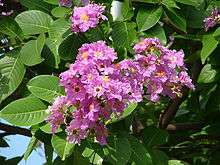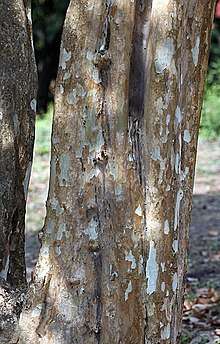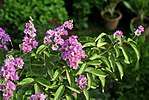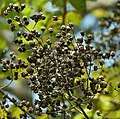Lagerstroemia speciosa
Lagerstroemia speciosa (giant crepe-myrtle, Queen's crepe-myrtle, banabá plant for Philippines, or pride of India[2]) is a species of Lagerstroemia native to tropical southern Asia.
| Lagerstroemia speciosa | |
|---|---|
 | |
| Flowers on a tree in Kolkata, West Bengal, India | |
| Scientific classification | |
| Kingdom: | Plantae |
| Clade: | Tracheophytes |
| Clade: | Angiosperms |
| Clade: | Eudicots |
| Clade: | Rosids |
| Order: | Myrtales |
| Family: | Lythraceae |
| Genus: | Lagerstroemia |
| Species: | L. speciosa |
| Binomial name | |
| Lagerstroemia speciosa (L.) Pers. | |
| Synonyms[1] | |
| |
Etymology
The genus Lagerstroemia was first described by Carl Linnaeus. The name Lagerstroemia recognizes Magnus von Lagerstroem, a Swedish naturalist who provided specimens from the East for Linnaeus.
Names
Growth

It is a small to medium-sized tree growing to 20 metres (66 ft) tall, with smooth, flaky bark. The leaves are deciduous, oval to elliptic, 8–15 cm (3.1–5.9 in) long and 3–7 cm (1.2–2.8 in) broad, with an acute apex. The flowers are produced in erect panicles 20–40 cm (7.9–15.7 in) long, each flower with six white to purple petals 2–3.5 cm (0.79–1.38 in) long. The flowers in this plant blooms only once in a year at the peak of summer.
Cultivation and uses
It is grown in South East Asia, India , Bangladesh and the Philippines. It is also widely cultivated as an ornamental plant in tropical and subtropical areas. The leaves of the banabá and other parts are used widely in the Philippines, Taiwan, and Japan as a tea preparation. Banabá herb is one of the 69 herbal plants promoted by the Philippine Department of Health (DOH).[3] In Vietnam the plant's young leaves are consumed as vegetables, and its old leaves and mature fruit are used in traditional medicine for reducing glucose in blood.[4]
The seeds have narcotic properties.[5]
Chemistry
Chemical compounds that have been isolated from the extract include corosolic acid, lager-stroemin, flosin B, and reginin A.[6]
Recognition
Pride of India or Tāmhan in Marathi is recognised as the state flower of the state of Maharashtra in India.[7]
In Buddhism
In Theravada Buddhism, this plant is said to have been used as the tree for achieved enlightenment, or Bodhi by the eleventh Lord Buddha ("Paduma – පදුම"), and the twelfth Lord Buddha (Naarada – නාරද). The plant is known as මුරුත (Murutha) in Sinhala and Mahaasona – මහාසොණ in Sanskrit.
Gallery




- Lagerstroemia Speciosa, in Narsingdi, Bangladesh
.jpg) Local called Banaba flower in Camarines Sur, Philippines
Local called Banaba flower in Camarines Sur, Philippines
References
- Lagerstroemia speciosa (L.) Pers. — The Plant List
- "Lagerstroemia speciosa (L.) Pers. pride of India." PLANTS Profile, United States Department of Agriculture / Natural Resources Conservation Service. Retrieved 2008-07-15.
- Eduardo B. Principe and Aurora S. Jose (2002). "Propagation Management Of Herbal and Medicinal Plants" (PDF). Research Information Series On Ecosystems. Retrieved 25 January 2013.
- Tanaka, Yoshitaka; Van Ke, Nguyen (2007). Edible Wild Plants of Vietnam: The Bountiful Garden. Thailand: Orchid Press. p. 90. ISBN 978-9745240896.
- Hargreaves, Dorothy; Hargreaves, Bob (1970). Tropical Trees of the Pacific. Kailua, Hawaii: Hargreaves. p. 16.
- "Antidiabetes and Anti-obesity Activity of Lagerstroemia speciosa"
- "Maharashtra State Symbols". www.onlinesaraswati.com. Retrieved 2019-10-17.
- Huxley, A., ed. (1992). New RHS Dictionary of Gardening 3: 10.
External links
| Wikimedia Commons has media related to Lagerstroemia speciosa. |